It’s not hard to understand why sedans aren’t selling. They are too small. Even a full-size sedan hasn’t got much trunk. And what trunk it’s got is isolated from the rest of the car. Sometimes, there’s a pass-through, but it’s usually a small rectangular hole through which maybe you can poke one long and thin item – like a set of ski poles – through to the passenger compartment. But you’ll never get as much big stuff in the trunk as you could in a hatchback’s . . . back.
Access is wide-open, through the rear liftgate – and the entire space opens continuously into the passenger compartment. You can fold the rear seats flat and now you have easily three times the cargo room as a same-sized sedan.
Which is one of the reasons why hatchbacks like the new Elantra GT are selling – while sedans are having a tougher time finding homes.
The Elantra GT isn’t just a hatchback’d version of the compact-sized Elantra sedan. It’s actually a different model that uses the same name. It has a shorter wheelbase – and is a full nine inches shorter overall – but (being a hatchback vs. a sedan) the GT has 55.1 cubic feet of total cargo capacity vs. 14.4 cubic feet for the Elantra sedan’s trunk.
Hyundai brought it over from Europe to counter competitor hatchbacks like the Mazda3 and VW Golf, among others.
There are some similarities, including shared engines – but the two Elantras are more like cousins than brothers.
Base price for the GT with the standard 2.0 liter engine and a six-speed manual transmission is $19,350. The Elantra sedan with the same drivetrain – but much less interior space – is considerably less expensive: $16,950 to start.
The GT Sport bumps you up to a turbocharged 1.6 liter engine, available with a six-speed manual for $23,250 to start and $24,350 with the optionally available seven-speed automated manual transmission.
WHAT’S NEW
The GT isn’t exactly new – just new to the United States.
Hyundai began selling this version of the Elantra in Europe – as the i30 – and is now selling it here as the Elantra GT.
Because hatchbacks sell.
Much more room inside than inside the sedan (and vs. rival hatchbacks, too).
Manual transmission available with both engines – not just the base (and less powerful) engine.
Available with a hot engine. Some rivals only offer just one (not-very-hot) engine.
WHAT’S NOT SO GOOD
The extra space costs . . . extra. It’s a $2,400 bump up from the Elantra sedan to the GT hatchback.
Lose a little backseat legroom vs. the sedan.
Inconveniently mounted (center of dashboard) door lock/unlock button.
The GT’s standard engine is the same engine that’s standard in the Elantra sedan. It’s a 2.0 liter turbo four – no turbo – making 161 hp and paired with either a six-speed manual or a six-speed automatic transmission.
So equipped, this one will get you to 60 in just over 7 seconds and rates an EPA-estimated 23 city, 31 highway.
These figures stack up favorably/comparably to those of other small hatches like the Mazda3 and VW Golf. 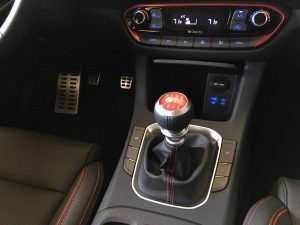
Next up – standard in the GT Sport – is the same turbocharged 1.6 liter engine that’s also optional in the sedan. It ups the ante to 201 hp – more horsepower than the Mazda3’s hatch’s optional 2.5 liter engine (184 hp) and the VW Golf’s standard (and only) 1.8 liter, 170 hp engine – and you can go with either a six-speed manual or a seven-speed automated manual.
This is a major hardware upgrade for the class. Automated manuals shift extremely quickly and – unlike a conventional automatic – they cost you less horsepower (and so, acceleration) with the side benefit of boosting fuel economy. More on that in a moment.
Th Elantra GT Sport gets to 60 in a speedy six seconds or so.
And it gets you there using less fuel. EPA says 26 city, 32 highway with the seven-speed automated manual.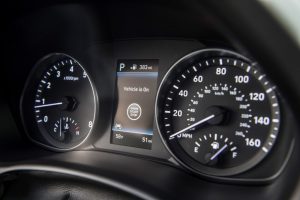
Yes, really.
Even with the less efficient six-speed shift-it-yourself manual, the Elantra GT Sport’s turbocharged 1.6 liter engine uses only negligibly more fuel than the base 2.0 liter engine: 22 city, 29 highway.
That’s having your turbo-boosted performance cake and eating it, too!
Most of the fun driving is at this end of the market now.
Fun, in the first place, because cars like the Elantra GT are still affordable, so you can get into one before you’re old and care more about soft seats than speed shifts.
It – and cars like it – have assumed the Youth Market role that V8 muscle cars one held, a long time ago – when people just out of high school were able to afford driving them.
They can no longer afford them.
But the Elantra GT – even the turbocharged GT Sport – they can afford. And the concept is similar, too. People forget that the first muscle cars began as economy cars that were made into fun cars by hotting them up under the hood, adding complementary heavy-duty suspensions, decorating them with colorful paint jobs and so on – but keeping the price manageable.
Sound familiar?
Sure, the Elantra is front wheel drive and it’s powered by a four cylinder engine. What could that possibly have in common with a rear-drive and V8 powered muscle car?
Well, for one, they’re side-by-side 0-60 and at the end of the quarter mile. Not many classic-era V8 muscle cars were quicker than the Elantra GT – and the turbocharged GT Sport is quicker than almost all of them. The way the power flows is different, but the end result is very similar.
You can squeal tires, for instance. Not the rear tires – but the fun is still there, just differently oriented. And the turbo’d GT Sport can squeal tires while rolling, too – a trick only the very strongest classic-era muscle cars could pull off. They had torque – the Hyundai has boost.
The effect is the same.
Manual or automatic, the tires will slip and skitter like a spring rabbit if you hammer the accelerator of the turbo GT Sport from about 10 MPH and keep your foot in it. And just like a muscle car on the edge of traction, you can modulate slippage via your right foot. Back off just enough to let the tires bite, but leave some rubber in your wake.
You can chirp the tires on the 1-2 upshift in the regular Elantra, too – because you can shift for yourself. It is becoming almost impossible to find a sedan that’s available with a manual transmission. Hyundai offers that in both versions of this thing.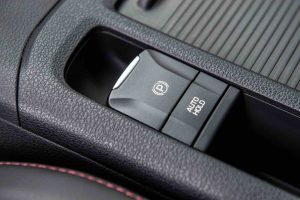
The one thing that’s missing from this thing is a manual (pull-up) emergency brake. Instead, there’s a button on the center console which you press to engage the parking brake. This is being done across the industry – mainly for “packaging” reasons. It’s simpler to assemble cars this way, using plug-in modules rather than having to run and manually adjust a cable.
But you can’t make 90 degree turns with an electric parking brake. This car ought to have a pull-up emergency brake lever for exactly that reason. 
Both the GT and the GT Sport do come through with pretty stout final drives – 4.33 for the GT and 4.46 for the turbo. That’s stouter than the 3.90-4:11 rear gears the most aggressive muscle car had – and it explains why these cars jump when you ask them to – just like the old muscle cars.
But unlike the old muscle cars – which didn’t have overdrive gearing in their transmissions – the Hyundai can cruise at 80 without the engine screaming at two-thirds redline.
It’s also why these cars are faster on top than almost every classic muscle car. They’ll each do 130-plus. Only a few of the old maulers could hit that speed before hitting redline – they were mechanically limited to speeds below what most economy cars can easily hit today.
Speaking of packaging. . .
Hyundai has managed to out-package VW.
The Golf was the most space-efficient hatch in this class. It’s still the shortest overall – just 167.5 inches bumper-to-bumper vs. 170.9 inches for the Elantra GT – but the Hyundai has more room inside.
And that’s no small thing.
Behind the second row, the Elantra GT has class-best cargo capacity – 24.9 cubic feet (vs. a 14.4 cubic foot trunk in the Elantra sedan) and with the second row seats folded, an also-class-best 55.4 cubic feet of space. The VW comes close, with 22.8 cubic feet behind its second row and 52.7 cubic feet with the second row folded.
But it’s no longer king.
The very pretty Mazda3 hatchback is less cargo-capacious than either. It has 20.2 cubic feet behind its second row, maxing out to 47.1 cubic feet with the second row folded. That long, sexy nose is to blame.
But perhaps the most interesting dimensional difference is the nine-inch difference in length between the Elantra sedan (179.9 inches) and the Elantra GT hatchback – and between the GT and the sexy but lengthy (180.3 inches) Mazda hatchback.
Not having those additional inches can make all the difference when you’re trying to park curbside.The GT gives you more wiggle room – without giving up inside room.
The hatch does have slightly less backseat legroom – 34.8 inches vs. 35.7 inches in the sedan – but it’s not a deal-breaker.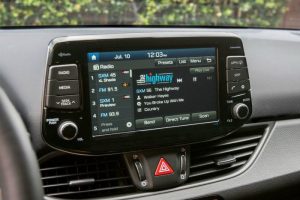
The GT has its own specific interior layout – including a standard 8-inch, iPad-style touchscreen that free-stands on top of the center stack. The Elantra sedan’s is smaller – and mounted lower – in the center stack. GT Sports get a larger (4.2 inch) main gauge cluster (a 3.5 inch display is standard in the regular GT.
It might take you a minute or several to figure out where the lock/unlock button is. The GT has just one button, mounted on the center stack (most cars have a button on each door panel). But there are also buttons on each exterior door pull. If you have your fob in your pocket, pushing the button will unlock the doors that way, too.
You can start the GT remotely – but differently. Instead of using the key fob or even your smartphone, just ask Alexa. Hyundai has set the car up so you can communicate with it that way. And not just turn the engine on if it’s cold or hot outside. But when the outside temperature reaches whatever temperature you decide. It’ll kick on – and cool off (or heat up) automatically.
You can get a full-auto Smart Cruise Control system in the GT Sport that is capable of bringing the car to a complete stop – if traffic ahead of you stops – and then accelerating the car just as automatically when traffic starts moving again. This can be helpful in the tedium of stop-and-go traffic – but on the other hand, it also arguably encourages people to space out behind the wheel. Until the fully automated car is perfected – here’s to hoping that never happens – it might be better if the driver remained obliged to apply the brakes and gas as necessary.
Another feature which Hyundai offers in both the GT and the GT Sport is the option to buy a premium Infinity Clari-Fi audio rig, which in addition to sounding great also has a playback function (for the satellite radio) so you can go back and re-hear something you really liked – or something you just missed.
THE BOTTOM LINE
Maybe it’s not a ’64 GTO with a 389 and Tri Power. But in some ways, it’s very much in keeping with that concept.
And in other ways, it’s even better.
The GTO, after all, could not haul a ‘fridge home from Lowes. You couldn’t sleep in it (not lying down) and it absolutely did not average close to 30 MPG – as my test car did during the week I ran around in it.
Seems like a not bad latter-day interpretation of a once-winning recipe.
Betcha it wins again.
. . .
Got a question about cars – or anything else? Click on the “ask Eric” link and send ’em in!
If you like what you’ve found here, please consider supporting EPautos.
We depend on you to keep the wheels turning!
Our donate button is here.
If you prefer not to use PayPal, our mailing address is:
EPautos
721 Hummingbird Lane SE
Copper Hill, VA 24079
PS: EPautos magnets are free to those who send in $20 or more. My latest eBook is also available for your favorite price – free! Click here. If you find it useful, consider contributing a couple of bucks! 


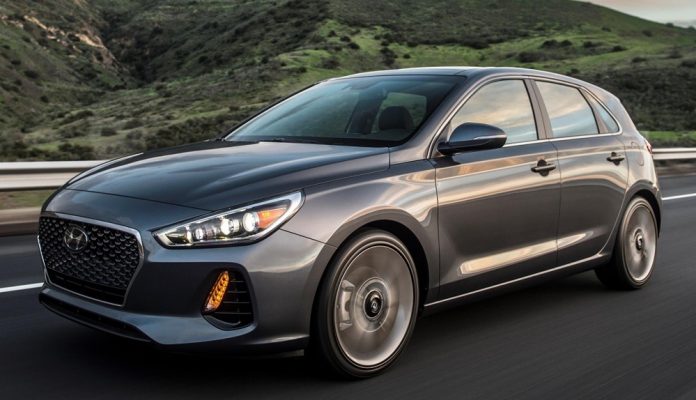





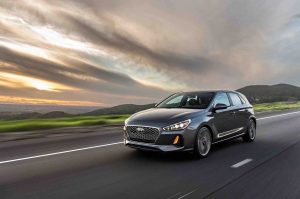

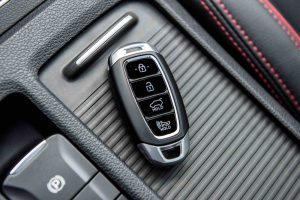
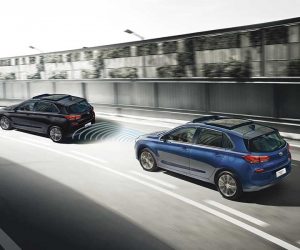








Great test writeup. Looks like Hyundai now builds the better Golf.
Makes me reflect on my 2 hot hatches in the 80’s & 90’s – my ’85 Golf GTI and my ’89 Acura Integra, both were reliable, practical & zippy cars that got good fuel mileage.
Here in Yurrup I had an 2017 Opel Astra that was very practical & efficient but lacked some room we needed. Now drive a BMW 3 series wagon diesel X-Drive and it’s wonderful: practical, roomy, efficient and drives great. If Alfa Romeo offered Giulia in a wagon it would sell in Europe, IMO.
Thanks, Jimmie!
Should have my write-up on the 2019 Ford F-150 up later today or tomorrow, mojo depending…
Thats not a station wagon. I remember my dads wagon. It was the size of a yukon xl with the third row down. Cars today are tiny. Even these hatches.
Hi C_lover,
This is true!
I think part of the reason for the declining interest in cars is precisely that; they are too small. The affordable full-size/RWD/V8 sedan is a thing of the past.
Thanks to the government.
This car looks very sharp and premium. Hyundai-Kia was smart by snagging Peter Schreyer to run its design department. I remember how cheap H/K cars used to look many years ago. They’ve really made a lot of progress since then. Good for them.
Hi Handler,
Agreed – I liked it, also (you can probably tell from my write-up)! I strongly recommend the six-speed manual version of this car. It’s almost as fun as my long-gone ’78 Z28 with the Super T-10!
This car fits my needs perfectly. I can fit plenty of small dog crates in there. And I do want a fun-to-drive car without getting raped by the insurance mafia. Best of all, I can pay cash for it. Hmm….
I love the review. Good comparison. While I realize that I am by far the exception in the 20’s demographic, I have to say that the Alexa feature is a would-be deal breaker for me if I were looking to buy a new car. All the damn “smart” tech just turns me off… ESPECIALLY when it comes to cars! However, I don’t mind performance related smart tech like traction control (which can be nice in certain conditions) IF it comes with a switch to turn it off too for when I want to feel the road. Keep up the great articles.
Thanks, Mark!
On Alexa – I am pretty sure you can turn that off or just not use it. Plus, it’s optional.
Damn, I LIKE this car. Good thing it offers an Infinity “Clari-FI” audio rig, because they sure appropriated the front end right off an Infinity. I like that attitude too. Just like Pontiac ripped off the “GTO” name.
Better yet, it’s not a CUV. Marketing wise, they won’t call it what it is….a Station Wagon. But we know, don’t we? 😉
Nice presentation of the similarities to muscle cars.
Just like Honda and Toyota kicked sand in the face of complacent American brands back when, the Koreans are about to do likewise to them.